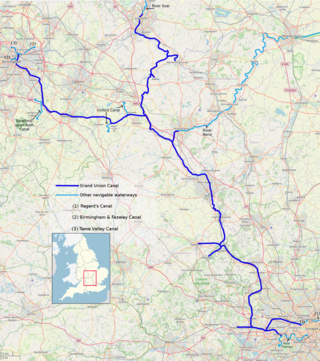
The Grand Union Canal in England is part of the British canal system. It is the principal navigable waterway between London and the Midlands. Starting in London, one arm runs to Leicester and another ends in Birmingham, with the latter stretching for 137 miles (220 km) with 166 locks from London. The Birmingham line has a number of short branches to places including Slough, Aylesbury, Wendover, and Northampton. The Leicester line has two short arms of its own, to Market Harborough and Welford.
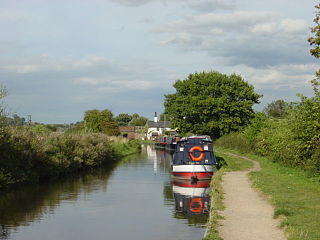
The Trent and Mersey Canal is a 93+1⁄2-mile (150 km) canal in Derbyshire, Staffordshire and Cheshire in north-central England. It is a "narrow canal" for the vast majority of its length, but at the extremities to the east of Burton upon Trent and north of Middlewich, it is a wide canal.

The Oxford Canal is a 78-mile (126 km) narrowboat canal in southern central England linking the City of Oxford with the Coventry Canal at Hawkesbury via Banbury and Rugby. Completed in 1790, it connects to the River Thames at Oxford, and links with the Grand Union Canal, which it is combined with for 5 miles (8 km) between to the villages of Braunston and Napton-on-the-Hill.

Braunston is a village and civil parish in the West Northamptonshire unitary authority area of Northamptonshire, England, next to the border with Warwickshire. At the 2011 Census, the parish had a population of 1,759. Braunston is situated just off the A45 main road and lies between the towns of Daventry and Rugby. Braunston is a hilltop village, most famous for its canal junction between the Oxford Canal and the Grand Union Canal, and associated marina.

The Canal Museum, formerly known as the "National Waterways Museum Stoke Bruerne" and "The Canal Museum at Stoke Bruerne", is a canal museum located next to the Grand Union Canal just south of the Blisworth Tunnel, near the village of Stoke Bruerne in Northamptonshire. It is about 10 miles (16 km) north of Milton Keynes and 7 miles (11 km) south of Northampton near junction 15 of the M1 motorway.

The Coventry Canal is a navigable narrow canal in the Midlands of England.

William Jessop was an English civil engineer, best known for his work on canals, harbours and early railways in the late 18th and early 19th centuries.
The Grand Junction Canal is a canal in England from Braunston in Northamptonshire to the River Thames at Brentford, with a number of branches. The mainline was built between 1793 and 1805, to improve the route from the Midlands to London, by-passing the upper reaches of the River Thames near Oxford, thus shortening the journey.

Whilton Locks is the name of a flight of seven locks on the Grand Union Canal near Daventry, in the county of Northamptonshire, England. They are also referred to as Buckby Lock Flight.

Stoke Bruerne is a village and civil parish in West Northamptonshire, England, about 10 miles (16 km) north of Milton Keynes and 7 miles (11 km) south of Northampton.
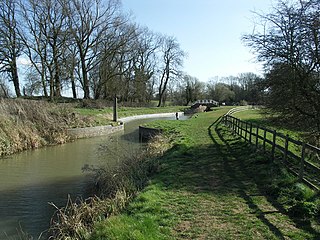
The Grand Union Canal was a canal in England from Foxton, Leicestershire on the Leicestershire and Northamptonshire Union Canal to Norton Junction, close to Long Buckby Wharf on the Grand Junction Canal. It now forms the first 23 miles (37 km) of the Leicester line of the Grand Union Canal.
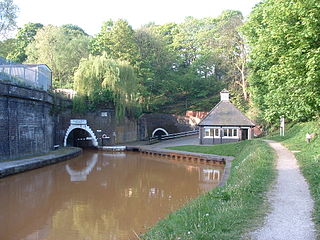
Harecastle Tunnel is a canal tunnel on the Trent and Mersey Canal in Staffordshire between Kidsgrove and Tunstall. The tunnel, which is 1.6 mi (2.6 km) long, was once one of the longest in the country. Its industrial purpose was for the transport of coal to the kilns in the Staffordshire Potteries. The canal runs under the 195 m (640 ft) Harecastle Hill near Goldenhill, the highest district in Stoke-on-Trent.

Blisworth is a village and civil parish in the West Northamptonshire, England. The West Coast Main Line, from London Euston to Manchester and Scotland, runs alongside the village partly hidden and partly on an embankment. The Grand Union Canal passes through the village and the north portal of the Blisworth tunnel is near Stoke Road.

Legging is a method of moving a boat through a canal tunnel or adit containing water. This method of navigating through canal tunnels and adits was commonly used in canal tunnels during the 18th and early 19th centuries.

Braunston Tunnel is on the Grand Union Canal about 830 yards (760 m) east of Braunston, Northamptonshire, England top lock. It is in the northern outskirts of Daventry, about 2 kilometres (1.2 mi) east of the village of Braunston.
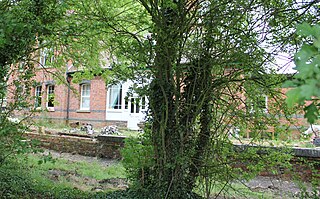
Stoke Bruern railway station was on the Stratford-upon-Avon, Towcester and Midland Junction Railway which opened on 1 December 1892 near the Northamptonshire village of Stoke Bruerne after which it was misnamed. Passenger services were withdrawn on 31 March 1893. It is arguable that Stoke Bruern along with Salcey Forest have a claim to have had the shortest passenger service of any British railway station. On the first service, it was reported that one person alighted at Salcey Forest, but no-one joined, whilst at Stoke Bruern, seven joined and one alighted. The service attracted no more than twenty passengers a week and the SMJ incurred a loss of £40. The station was situated in a sparsely populated area and only saw passenger services for four months, despite the railway company's optimism which saw substantial station facilities provided in the expectation of traffic which never came. The station remained open for goods until 1952.

Painted Boats is a British drama film directed by Charles Crichton and released by Ealing Studios in 1945. Painted Boats, one of the lesser-known Ealing films of the period, is brief, uses a little-known cast and has a slight storyline. It is however considered significant by waterways enthusiasts as a fictionalised documentary, providing a rare extensive filmic depiction of a long-gone way of life on England's working canal system in the 1940s. The narration was by Louis MacNeice, including some verse specially written to suit the onscreen action, most notably the sequence in which the narrow boat is being 'legged' through one of the tunnels. Much background information on canals and suggestions for suitable filming locations were provided by the writer L. T. C. Rolt, who also provided the title, and who records in his autobiography that he was disappointed to find that his name had not been included in the film's credits.

Easton Neston is situated in south Northamptonshire, England. Though the village of Easton Neston which was inhabited until around 1500 is now gone, the parish retains the name. At the 2011 Census the population of the civil parish remained less than 100 and was included in the town of Towcester.

Stoke Bruerne Brick Pits is a six hectare nature reserve in Stoke Bruerne in Northamptonshire. It is managed by the Wildlife Trust for Bedfordshire, Cambridgeshire and Northamptonshire.



















